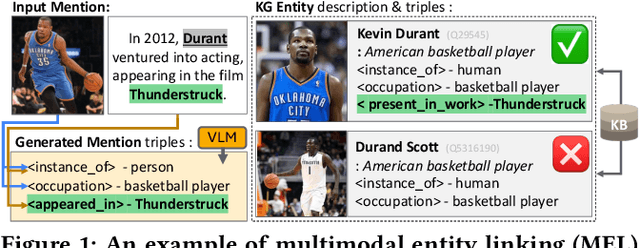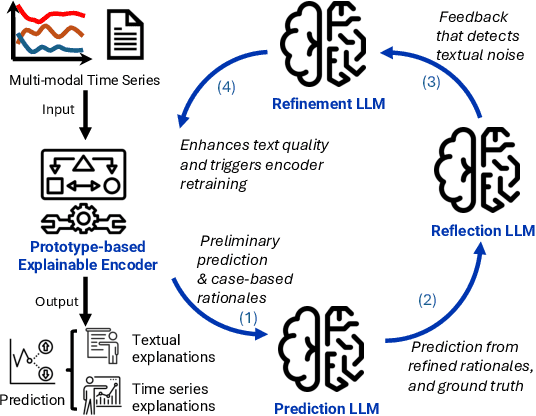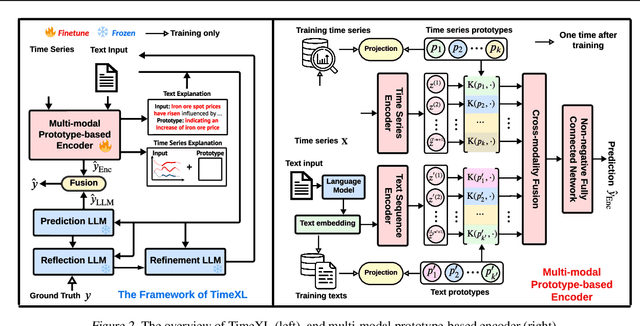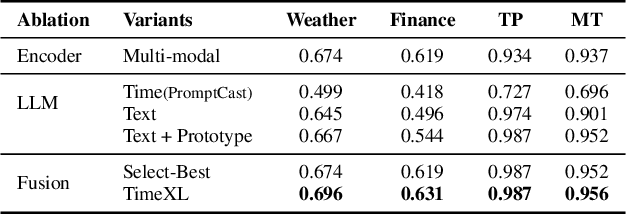Kijung Shin
A Self-Supervised Mixture-of-Experts Framework for Multi-behavior Recommendation
Aug 28, 2025Abstract:In e-commerce, where users face a vast array of possible item choices, recommender systems are vital for helping them discover suitable items they might otherwise overlook. While many recommender systems primarily rely on a user's purchase history, recent multi-behavior recommender systems incorporate various auxiliary user behaviors, such as item clicks and cart additions, to enhance recommendations. Despite their overall performance gains, their effectiveness varies considerably between visited items (i.e., those a user has interacted with through auxiliary behaviors) and unvisited items (i.e., those with which the user has had no such interactions). Specifically, our analysis reveals that (1) existing multi-behavior recommender systems exhibit a significant gap in recommendation quality between the two item types (visited and unvisited items) and (2) achieving strong performance on both types with a single model architecture remains challenging. To tackle these issues, we propose a novel multi-behavior recommender system, MEMBER. It employs a mixture-of-experts framework, with experts designed to recommend the two item types, respectively. Each expert is trained using a self-supervised method specialized for its design goal. In our comprehensive experiments, we show the effectiveness of MEMBER across both item types, achieving up to 65.46% performance gain over the best competitor in terms of Hit Ratio@20.
'Hello, World!': Making GNNs Talk with LLMs
May 27, 2025Abstract:While graph neural networks (GNNs) have shown remarkable performance across diverse graph-related tasks, their high-dimensional hidden representations render them black boxes. In this work, we propose Graph Lingual Network (GLN), a GNN built on large language models (LLMs), with hidden representations in the form of human-readable text. Through careful prompt design, GLN incorporates not only the message passing module of GNNs but also advanced GNN techniques, including graph attention and initial residual connection. The comprehensibility of GLN's hidden representations enables an intuitive analysis of how node representations change (1) across layers and (2) under advanced GNN techniques, shedding light on the inner workings of GNNs. Furthermore, we demonstrate that GLN achieves strong zero-shot performance on node classification and link prediction, outperforming existing LLM-based baseline methods.
KGMEL: Knowledge Graph-Enhanced Multimodal Entity Linking
Apr 21, 2025



Abstract:Entity linking (EL) aligns textual mentions with their corresponding entities in a knowledge base, facilitating various applications such as semantic search and question answering. Recent advances in multimodal entity linking (MEL) have shown that combining text and images can reduce ambiguity and improve alignment accuracy. However, most existing MEL methods overlook the rich structural information available in the form of knowledge-graph (KG) triples. In this paper, we propose KGMEL, a novel framework that leverages KG triples to enhance MEL. Specifically, it operates in three stages: (1) Generation: Produces high-quality triples for each mention by employing vision-language models based on its text and images. (2) Retrieval: Learns joint mention-entity representations, via contrastive learning, that integrate text, images, and (generated or KG) triples to retrieve candidate entities for each mention. (3) Reranking: Refines the KG triples of the candidate entities and employs large language models to identify the best-matching entity for the mention. Extensive experiments on benchmark datasets demonstrate that KGMEL outperforms existing methods. Our code and datasets are available at: https://github.com/juyeonnn/KGMEL.
Emergence of psychopathological computations in large language models
Apr 10, 2025Abstract:Can large language models (LLMs) implement computations of psychopathology? An effective approach to the question hinges on addressing two factors. First, for conceptual validity, we require a general and computational account of psychopathology that is applicable to computational entities without biological embodiment or subjective experience. Second, mechanisms underlying LLM behaviors need to be studied for better methodological validity. Thus, we establish a computational-theoretical framework to provide an account of psychopathology applicable to LLMs. To ground the theory for empirical analysis, we also propose a novel mechanistic interpretability method alongside a tailored empirical analytic framework. Based on the frameworks, we conduct experiments demonstrating three key claims: first, that distinct dysfunctional and problematic representational states are implemented in LLMs; second, that their activations can spread and self-sustain to trap LLMs; and third, that dynamic, cyclic structural causal models encoded in the LLMs underpin these patterns. In concert, the empirical results corroborate our hypothesis that network-theoretic computations of psychopathology have already emerged in LLMs. This suggests that certain LLM behaviors mirroring psychopathology may not be a superficial mimicry but a feature of their internal processing. Thus, our work alludes to the possibility of AI systems with psychopathological behaviors in the near future.
MARIOH: Multiplicity-Aware Hypergraph Reconstruction
Apr 01, 2025Abstract:Hypergraphs offer a powerful framework for modeling higher-order interactions that traditional pairwise graphs cannot fully capture. However, practical constraints often lead to their simplification into projected graphs, resulting in substantial information loss and ambiguity in representing higher-order relationships. In this work, we propose MARIOH, a supervised approach for reconstructing the original hypergraph from its projected graph by leveraging edge multiplicity. To overcome the difficulties posed by the large search space, MARIOH integrates several key ideas: (a) identifying provable size-2 hyperedges, which reduces the candidate search space, (b) predicting the likelihood of candidates being hyperedges by utilizing both structural and multiplicity-related features, and (c) not only targeting promising hyperedge candidates but also examining less confident ones to explore alternative possibilities. Together, these ideas enable MARIOH to efficiently and effectively explore the search space. In our experiments using 10 real-world datasets, MARIOH achieves up to 74.51% higher reconstruction accuracy compared to state-of-the-art methods.
Simple yet Effective Node Property Prediction on Edge Streams under Distribution Shifts
Apr 01, 2025



Abstract:The problem of predicting node properties (e.g., node classes) in graphs has received significant attention due to its broad range of applications. Graphs from real-world datasets often evolve over time, with newly emerging edges and dynamically changing node properties, posing a significant challenge for this problem. In response, temporal graph neural networks (TGNNs) have been developed to predict dynamic node properties from a stream of emerging edges. However, our analysis reveals that most TGNN-based methods are (a) far less effective without proper node features and, due to their complex model architectures, (b) vulnerable to distribution shifts. In this paper, we propose SPLASH, a simple yet powerful method for predicting node properties on edge streams under distribution shifts. Our key contributions are as follows: (1) we propose feature augmentation methods and an automatic feature selection method for edge streams, which improve the effectiveness of TGNNs, (2) we propose a lightweight MLP-based TGNN architecture that is highly efficient and robust under distribution shifts, and (3) we conduct extensive experiments to evaluate the accuracy, efficiency, generalization, and qualitative performance of the proposed method and its competitors on dynamic node classification, dynamic anomaly detection, and node affinity prediction tasks across seven real-world datasets.
TiGer: Self-Supervised Purification for Time-evolving Graphs
Mar 11, 2025Abstract:Time-evolving graphs, such as social and citation networks, often contain noise that distorts structural and temporal patterns, adversely affecting downstream tasks, such as node classification. Existing purification methods focus on static graphs, limiting their ability to account for critical temporal dependencies in dynamic graphs. In this work, we propose TiGer (Time-evolving Graph purifier), a self-supervised method explicitly designed for time-evolving graphs. TiGer assigns two different sub-scores to edges using (1) self-attention for capturing long-term contextual patterns shaped by both adjacent and distant past events of varying significance and (2) statistical distance measures for detecting inconsistency over a short-term period. These sub-scores are used to identify and filter out suspicious (i.e., noise-like) edges through an ensemble strategy, ensuring robustness without requiring noise labels. Our experiments on five real-world datasets show TiGer filters out noise with up to 10.2% higher accuracy and improves node classification performance by up to 5.3%, compared to state-of-the-art methods.
Multi-Behavior Recommender Systems: A Survey
Mar 10, 2025Abstract:Traditional recommender systems primarily rely on a single type of user-item interaction, such as item purchases or ratings, to predict user preferences. However, in real-world scenarios, users engage in a variety of behaviors, such as clicking on items or adding them to carts, offering richer insights into their interests. Multi-behavior recommender systems leverage these diverse interactions to enhance recommendation quality, and research on this topic has grown rapidly in recent years. This survey provides a timely review of multi-behavior recommender systems, focusing on three key steps: (1) Data Modeling: representing multi-behaviors at the input level, (2) Encoding: transforming these inputs into vector representations (i.e., embeddings), and (3) Training: optimizing machine-learning models. We systematically categorize existing multi-behavior recommender systems based on the commonalities and differences in their approaches across the above steps. Additionally, we discuss promising future directions for advancing multi-behavior recommender systems.
Explainable Multi-modal Time Series Prediction with LLM-in-the-Loop
Mar 02, 2025



Abstract:Time series analysis provides essential insights for real-world system dynamics and informs downstream decision-making, yet most existing methods often overlook the rich contextual signals present in auxiliary modalities. To bridge this gap, we introduce TimeXL, a multi-modal prediction framework that integrates a prototype-based time series encoder with three collaborating Large Language Models (LLMs) to deliver more accurate predictions and interpretable explanations. First, a multi-modal prototype-based encoder processes both time series and textual inputs to generate preliminary forecasts alongside case-based rationales. These outputs then feed into a prediction LLM, which refines the forecasts by reasoning over the encoder's predictions and explanations. Next, a reflection LLM compares the predicted values against the ground truth, identifying textual inconsistencies or noise. Guided by this feedback, a refinement LLM iteratively enhances text quality and triggers encoder retraining. This closed-loop workflow -- prediction, critique (reflect), and refinement -- continuously boosts the framework's performance and interpretability. Empirical evaluations on four real-world datasets demonstrate that TimeXL achieves up to 8.9\% improvement in AUC and produces human-centric, multi-modal explanations, highlighting the power of LLM-driven reasoning for time series prediction.
TimeCAP: Learning to Contextualize, Augment, and Predict Time Series Events with Large Language Model Agents
Feb 17, 2025Abstract:Time series data is essential in various applications, including climate modeling, healthcare monitoring, and financial analytics. Understanding the contextual information associated with real-world time series data is often essential for accurate and reliable event predictions. In this paper, we introduce TimeCAP, a time-series processing framework that creatively employs Large Language Models (LLMs) as contextualizers of time series data, extending their typical usage as predictors. TimeCAP incorporates two independent LLM agents: one generates a textual summary capturing the context of the time series, while the other uses this enriched summary to make more informed predictions. In addition, TimeCAP employs a multi-modal encoder that synergizes with the LLM agents, enhancing predictive performance through mutual augmentation of inputs with in-context examples. Experimental results on real-world datasets demonstrate that TimeCAP outperforms state-of-the-art methods for time series event prediction, including those utilizing LLMs as predictors, achieving an average improvement of 28.75% in F1 score.
 Add to Chrome
Add to Chrome Add to Firefox
Add to Firefox Add to Edge
Add to Edge